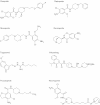Systematic review: cardiovascular safety profile of 5-HT(4) agonists developed for gastrointestinal disorders
- PMID: 22356640
- PMCID: PMC3491670
- DOI: 10.1111/j.1365-2036.2012.05011.x
Systematic review: cardiovascular safety profile of 5-HT(4) agonists developed for gastrointestinal disorders
Abstract
Background: The nonselective 5-HT(4) receptor agonists, cisapride and tegaserod have been associated with cardiovascular adverse events (AEs).
Aim: To perform a systematic review of the safety profile, particularly cardiovascular, of 5-HT(4) agonists developed for gastrointestinal disorders, and a nonsystematic summary of their pharmacology and clinical efficacy.
Methods: Articles reporting data on cisapride, clebopride, prucalopride, mosapride, renzapride, tegaserod, TD-5108 (velusetrag) and ATI-7505 (naronapride) were identified through a systematic search of the Cochrane Library, Medline, Embase and Toxfile. Abstracts from UEGW 2006-2008 and DDW 2008-2010 were searched for these drug names, and pharmaceutical companies approached to provide unpublished data.
Results: Retrieved articles on pharmacokinetics, human pharmacodynamics and clinical data with these 5-HT(4) agonists, are reviewed and summarised nonsystematically. Articles relating to cardiac safety and tolerability of these agents, including any relevant case reports, are reported systematically. Two nonselective 5-HT(4) agonists had reports of cardiovascular AEs: cisapride (QT prolongation) and tegaserod (ischaemia). Interactions with, respectively, the hERG cardiac potassium channel and 5-HT(1) receptor subtypes have been suggested to account for these effects. No cardiovascular safety concerns were reported for the newer, selective 5-HT(4) agonists prucalopride, velusetrag, naronapride, or for nonselective 5-HT(4) agonists with no hERG or 5-HT(1) affinity (renzapride, clebopride, mosapride).
Conclusions: 5-HT(4) agonists for GI disorders differ in chemical structure and selectivity for 5-HT(4) receptors. Selectivity for 5-HT(4) over non-5-HT(4) receptors may influence the agent's safety and overall risk-benefit profile. Based on available evidence, highly selective 5-HT(4) agonists may offer improved safety to treat patients with impaired GI motility.
© 2012 Blackwell Publishing Ltd.
Figures
Comment in
-
Commentary: towards a cardiac safe prokinetic.Aliment Pharmacol Ther. 2012 May;35(10):1243-4. doi: 10.1111/j.1365-2036.2012.05077.x. Aliment Pharmacol Ther. 2012. PMID: 22500472 No abstract available.
Similar articles
-
Drugs for preventing postoperative nausea and vomiting in adults after general anaesthesia: a network meta-analysis.Cochrane Database Syst Rev. 2020 Oct 19;10(10):CD012859. doi: 10.1002/14651858.CD012859.pub2. Cochrane Database Syst Rev. 2020. PMID: 33075160 Free PMC article.
-
Systematic review with meta-analysis: highly selective 5-HT4 agonists (prucalopride, velusetrag or naronapride) in chronic constipation.Aliment Pharmacol Ther. 2014 Feb;39(3):239-53. doi: 10.1111/apt.12571. Epub 2013 Dec 5. Aliment Pharmacol Ther. 2014. PMID: 24308797
-
Systemic pharmacological treatments for chronic plaque psoriasis: a network meta-analysis.Cochrane Database Syst Rev. 2021 Apr 19;4(4):CD011535. doi: 10.1002/14651858.CD011535.pub4. Cochrane Database Syst Rev. 2021. Update in: Cochrane Database Syst Rev. 2022 May 23;5:CD011535. doi: 10.1002/14651858.CD011535.pub5. PMID: 33871055 Free PMC article. Updated.
-
Systemic pharmacological treatments for chronic plaque psoriasis: a network meta-analysis.Cochrane Database Syst Rev. 2017 Dec 22;12(12):CD011535. doi: 10.1002/14651858.CD011535.pub2. Cochrane Database Syst Rev. 2017. Update in: Cochrane Database Syst Rev. 2020 Jan 9;1:CD011535. doi: 10.1002/14651858.CD011535.pub3. PMID: 29271481 Free PMC article. Updated.
-
Efficacy of 5-HT3 antagonists and 5-HT4 agonists in irritable bowel syndrome: systematic review and meta-analysis.Am J Gastroenterol. 2009 Jul;104(7):1831-43; quiz 1844. doi: 10.1038/ajg.2009.223. Epub 2009 May 26. Am J Gastroenterol. 2009. PMID: 19471254
Cited by
-
Prokinetics in the Management of Functional Gastrointestinal Disorders.J Neurogastroenterol Motil. 2015 Jul 30;21(3):330-6. doi: 10.5056/jnm15094. J Neurogastroenterol Motil. 2015. PMID: 26130629 Free PMC article.
-
Serotonin as a link between the gut-brain-microbiome axis in autism spectrum disorders.Pharmacol Res. 2018 Jun;132:1-6. doi: 10.1016/j.phrs.2018.03.020. Epub 2018 Mar 31. Pharmacol Res. 2018. PMID: 29614380 Free PMC article. Review.
-
New Developments in Prokinetic Therapy for Gastric Motility Disorders.Front Pharmacol. 2021 Aug 24;12:711500. doi: 10.3389/fphar.2021.711500. eCollection 2021. Front Pharmacol. 2021. PMID: 34504426 Free PMC article. Review.
-
Mosapride stimulates human 5-HT4-serotonin receptors in the heart.Naunyn Schmiedebergs Arch Pharmacol. 2024 Sep;397(9):6705-6720. doi: 10.1007/s00210-024-03047-1. Epub 2024 Mar 18. Naunyn Schmiedebergs Arch Pharmacol. 2024. PMID: 38498060 Free PMC article.
-
Second Asian Consensus on Irritable Bowel Syndrome.J Neurogastroenterol Motil. 2019 Jul 1;25(3):343-362. doi: 10.5056/jnm19041. J Neurogastroenterol Motil. 2019. PMID: 31327218 Free PMC article. Review.
References
-
- Sanger GJ, Alpers DH. Development of drugs for gastrointestinal motor disorders: translating science to clinical need. Neurogastroenterol Motil. 2008;20:177–84. - PubMed
-
- Briejer MR, Akkermans LM, Schuurkes JA. Gastrointestinal prokinetic benzamides: the pharmacology underlying stimulation of motility. Pharmacol Rev. 1995;47:631–51. - PubMed
-
- Langlois M, Fischmeister R. 5-HT4 receptor ligands: applications and new prospects. J Med Chem. 2003;46:319–44. - PubMed
-
- Evans BW, Clark WK, Moore DJ, Whorwell PJ. Tegaserod for the treatment of irritable bowel syndrome and chronic constipation. Cochrane Database Syst Rev. 2007:CD003960. - PubMed
-
- McCallum RW, Prakash C, Campoli-Richards DM, Goa KL. Cisapride. A preliminary review of its pharmacodynamic and pharmacokinetic properties, and therapeutic use as a prokinetic agent in gastrointestinal motility disorders. Drugs. 1988;36:652–81. - PubMed
Publication types
MeSH terms
Substances
LinkOut - more resources
Full Text Sources
Other Literature Sources


